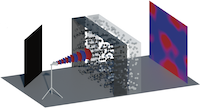In a new theory paper by Oliver and Dmitry just published in Physical Review Letters, we show that placing two atoms into a “fish eye cavity” results in a periodic emission and absorption of a single photon between them – similar to an ultrafast ping-pong game at the speed of light. See the press release of TU Wien for more information.











